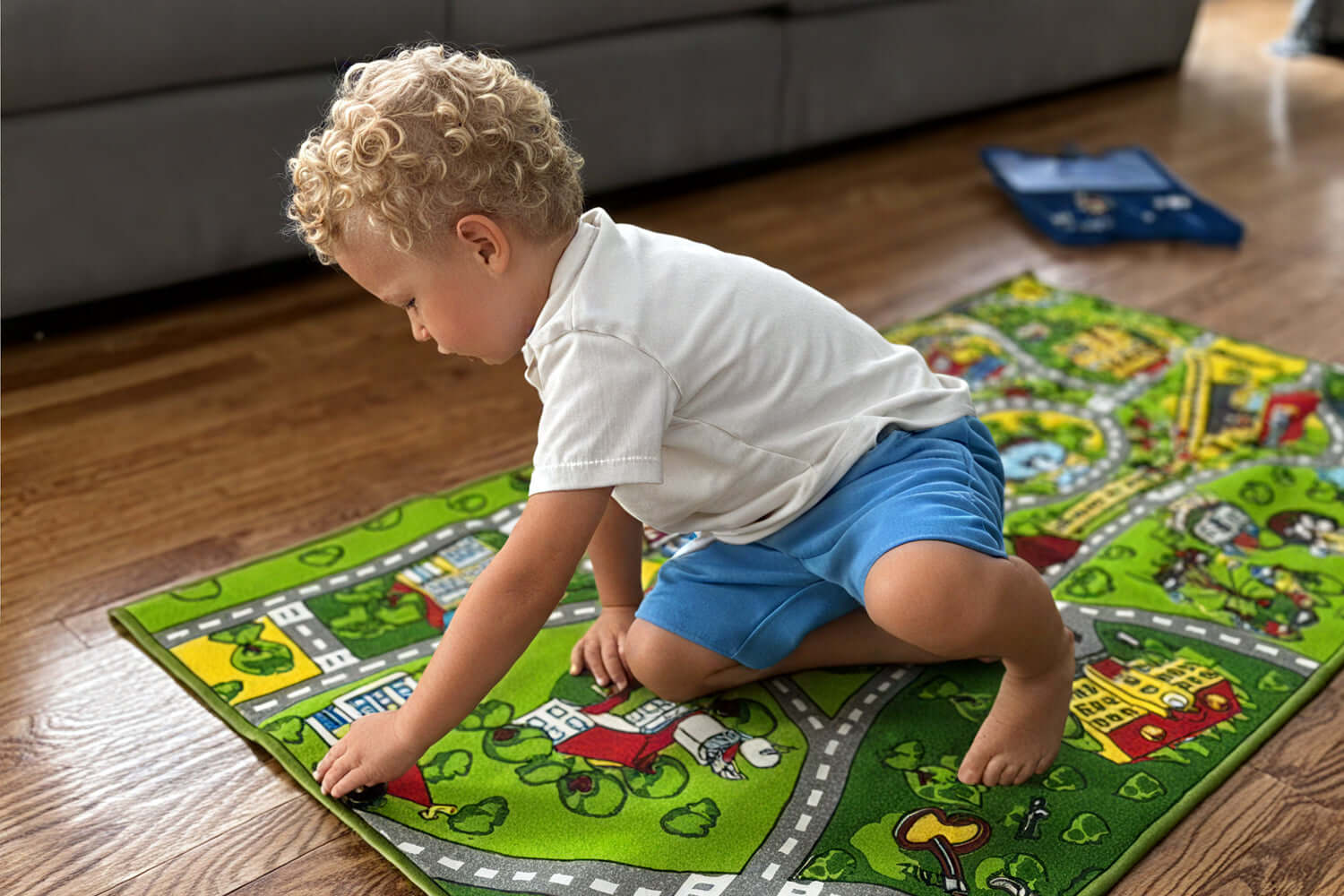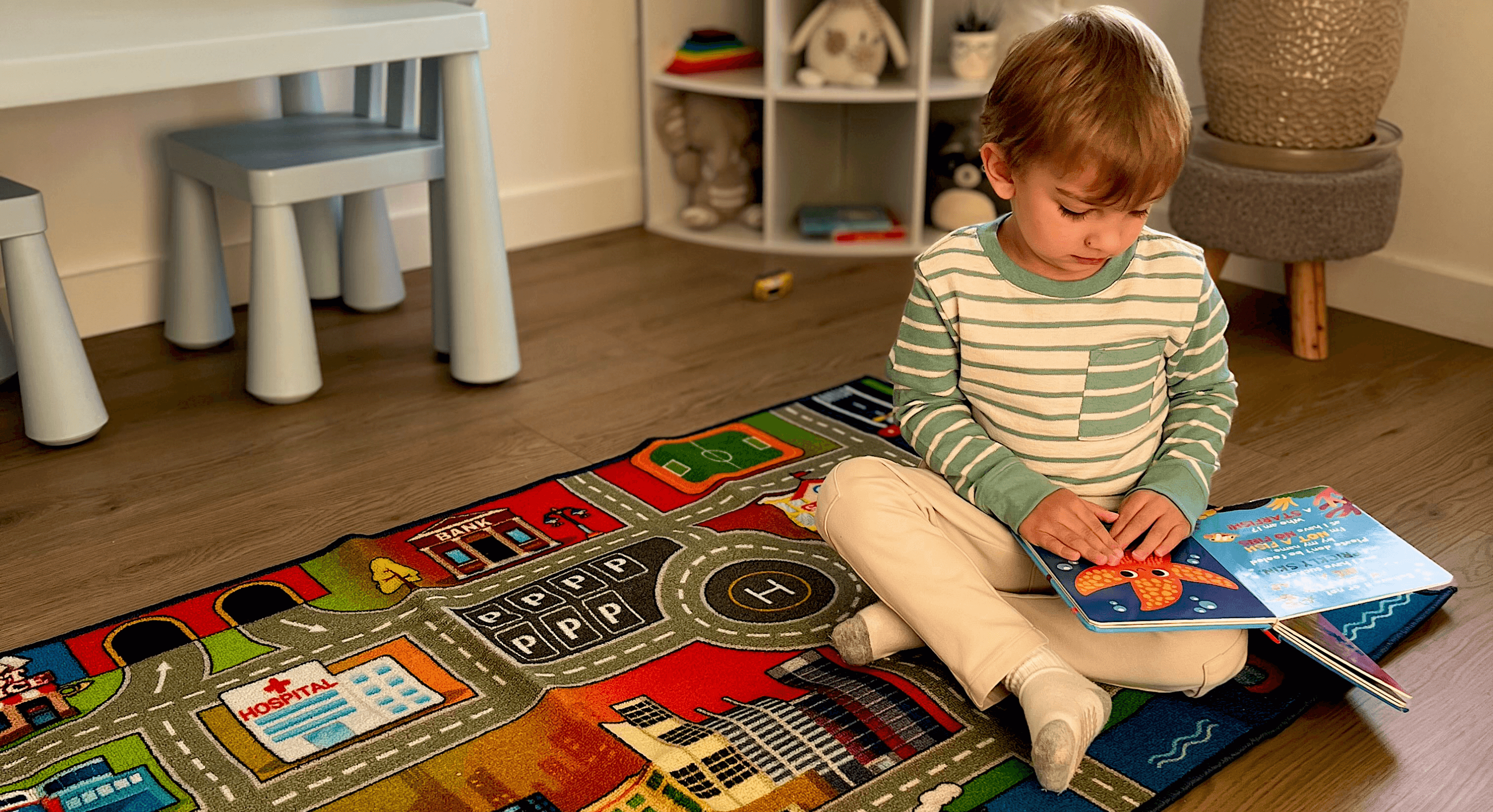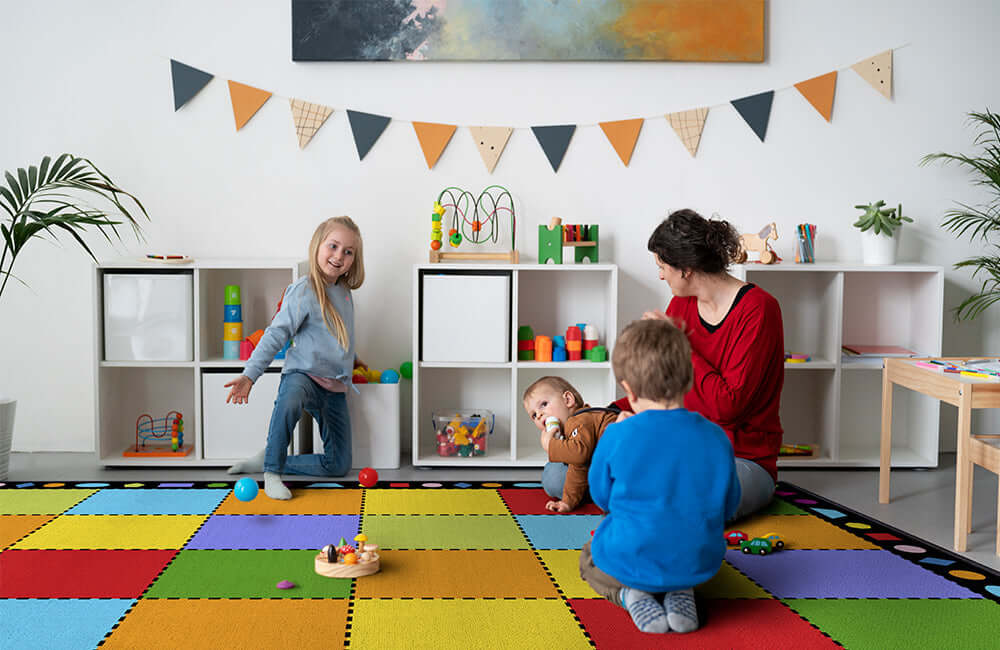Early Childhood Foundations (Ages 3-5)
The early childhood years represent a critical period of rapid development when children are concrete thinkers who learn primarily through sensory experiences and play.
As noted by the National Association for the Education of Young Children (NAEYC), developmentally appropriate practice for this age requires "meeting children where they are—which means that teachers must get to know them well—and enabling them to reach goals that are both challenging and achievable" (Penn State Extension, n.d.).
Developmental Considerations for Early Childhood
Young children in this stage:
- Process information concretely rather than abstractly
- Learn best through multi-sensory experiences
- Benefit from clearly defined physical spaces
- Need support for emerging social skills
- Thrive with opportunities for movement and active learning
Our Early Childhood Rug Solutions
Our Kids Rug Collection includes developmentally appropriate options that support early learning while maintaining clean, minimalist design principles:
Sensory-Friendly Design Elements
- Subtle texture variations provide tactile feedback
- Clear visual boundaries help with spatial organization
- Moderate color contrasts that engage without overwhelming
Movement Support The By Moment Collection includes circle time rugs with defined seating spaces that help young children understand personal boundaries while supporting group activities—an essential developmental task for this age group.
Minimalist Approach for Young Learners While many preschool rugs feature overwhelming patterns and characters, our early childhood options maintain visual clarity with thoughtful design that supports focus rather than causing distraction, aligning with research showing that "children can better concentrate on their studies" in simplified environments (Pedagogue, 2023).
Elementary Learning Environments (Ages 6-10)
Elementary students experience significant cognitive growth, developing increasing capacity for abstract thinking while still benefiting from concrete learning supports.
According to developmental education principles, this stage requires environments that "foster development and learning for each child across all domains and subject areas" (NAEYC, n.d.).
Developmental Considerations for Elementary Students
Children in this age range:
- Begin developing higher-order thinking skills
- Need support transitioning between concrete and abstract concepts
- Develop increasing independence and agency
- Benefit from organized, predictable environments
- Require spaces that support both collaborative and individual work
Our Elementary School Rug Solutions
The Seating Rugs for Classrooms collection offers minimalist designs that create structure without visual clutter:
Flexible Learning Zone Support Our Large Classroom Rugs feature subtle zone indicators that support the transition between different learning modalities—collaborative work, independent study, and small group instruction—without overwhelming visual elements.
Agency and Independence Elementary designs include clear but minimal visual cues that help students navigate the classroom independently, supporting what Resources for Early Learning describes as children becoming "self-regulated learners" who can "manage strong emotions, control impulses, and stay on task with minimum distraction" (Resources for Early Learning, n.d.).
Minimalist Color Application While maintaining visual interest, our elementary rugs use controlled color palettes that reduce the cognitive load of processing excessive visual information—a key principle in minimalist classroom design that supports focus and attention.
Middle School Transitions (Ages 11-14)
As students enter adolescence, their cognitive abilities become more sophisticated, but they face new challenges in executive function, social dynamics, and emotional regulation.
Developmentally appropriate design for this age group respects their increasing maturity while providing necessary structure and support.
Developmental Considerations for Middle School Students
Adolescents in this stage:
- Develop more advanced abstract thinking capabilities
- Navigate complex social identities and peer relationships
- Need environments that respect their growing maturity
- Benefit from spaces that support executive function
- Require balance between structure and autonomy
Our Middle School Rug Solutions
The By Style Collection includes options with sophisticated designs appropriate for older students:
Sophisticated Minimalism Our middle school options feature clean lines and contemporary designs that acknowledge students' developing aesthetic preferences without creating distracting environments.
Collaborative Space Definition For this age group that increasingly learns through peer interaction, our rugs create subtle boundaries for collaborative workspaces while maintaining the visual simplicity that supports focus and attention.
Executive Function Support The thoughtful organization of our middle school rugs creates predictable environmental structures that support students' developing executive function skills, which Maryland's Open Source Textbook Commons notes are essential for "self-regulated learners" (Maryland Open Source Textbook Commons, n.d.).
Selecting Developmentally Appropriate Rugs: A Guide by Age
When choosing the perfect Booooom Jackson rug for your learning environment, consider these developmentally informed recommendations:
For Early Childhood (Ages 3-5)
- Best Collections: Kids Rug, By Moment - Circle Time
- Key Features: Clear seating markers, moderate sensory elements, defined boundaries
- Size Recommendations: Smaller circle rugs for intimate gatherings, medium rectangular rugs (5'x7') for play areas
For Elementary (Ages 6-10)
- Best Collections: Seating Rugs, By Size - Medium
- Key Features: Multi-functional zones, balanced visual elements, flexible seating options
- Size Recommendations: Larger rectangular rugs (7'x13', 9'x12') for whole-class seating
For Middle School (Ages 11-14)
- Best Collections: By Style - Contemporary, Large Classroom Rugs
- Key Features: Sophisticated designs, collaborative space definition, minimal visual elements
- Size Recommendations: Area rugs for specific learning zones rather than whole-class seating
Implementation Tips: Creating Developmentally Appropriate Minimalist Spaces
Integrating developmental design principles with minimalist classroom aesthetics requires thoughtful implementation. Here are expert-informed strategies for creating age-appropriate minimalist spaces with our classroom rugs:
1. Apply Age-Appropriate Minimalism
Remember that minimalism looks different across age groups. As noted in the article "3 Design Moves to Create a Minimalist Classroom," early childhood spaces can incorporate bright colors as accents within an otherwise clean design, while older students benefit from more neutral tones (Preschool Rock, 2023).
Early Childhood: Use our rugs as colorful focal points in otherwise uncluttered spaces
Elementary: Balance our moderately colored rugs with neutral walls and minimal decor
Middle School: Choose rugs with sophisticated designs and subdued colors for mature aesthetic
2. Create Predictable Environments That Support Independence
The National Center on Safe Supportive Learning Environments emphasizes that developmentally appropriate practice helps build positive classroom climate and ensures "that each child is seen for their unique potential".
Early Childhood: Use our circle time rugs to create predictable gathering spaces
Elementary: Implement our zoned rugs to help students understand different learning areas
Middle School: Select our minimalist designs that create subtle zone differentiation without infantilizing the space
3. Consider Cultural Appropriateness
Truly developmentally appropriate design considers not only age but also cultural context.
Our minimalist rug designs offer versatility that respects diverse cultural backgrounds while supporting learning.
All Ages: Choose our neutral designs that can be integrated with culturally relevant elements
Community Representation: Use our rugs as foundations for spaces that can showcase student work and cultural artifacts
4. Support Agency and Choice
Developmentally appropriate environments encourage children's agency—their ability to make choices and affect their environment. Our minimalist rugs create defined yet flexible spaces that support this developmental need.
Early Childhood: Use our simple designs to create choice areas for play and exploration
Elementary: Implement our flexible seating rugs that allow students to choose their learning positions
Middle School: Select our sophisticated designs that create mature spaces for student-directed learning
Conclusion: The Developmental Design Advantage
At Booooom Jackson, we believe that truly effective classroom design must balance aesthetic considerations with developmental appropriateness.
Our minimalist classroom rugs support both goals, creating visually calming environments that respect and respond to children's developmental needs at every age.
When you choose Booooom Jackson for your classroom, you're not just selecting beautiful, high-quality rugs—you're investing in thoughtfully designed products that support children's cognitive, physical, social, and emotional development while creating the focused, distraction-free environments that enhance learning at every stage.
Ready to transform your learning space with developmentally appropriate minimalist design?
Explore our comprehensive classroom rug collection or browse by age-appropriate activities to find the perfect foundation for your students' growth and learning.




Leave a comment
This site is protected by hCaptcha and the hCaptcha Privacy Policy and Terms of Service apply.